‘Gangsters vs. Nazis’ book tells how a New York judge secretly directed mafia bosses Meyer Lansky and Bugsy Siegel to recruit an army of Jewish thugs to intimidate antisemites
By RENEE GHERT-ZAND, TOI Today, 11:02 am
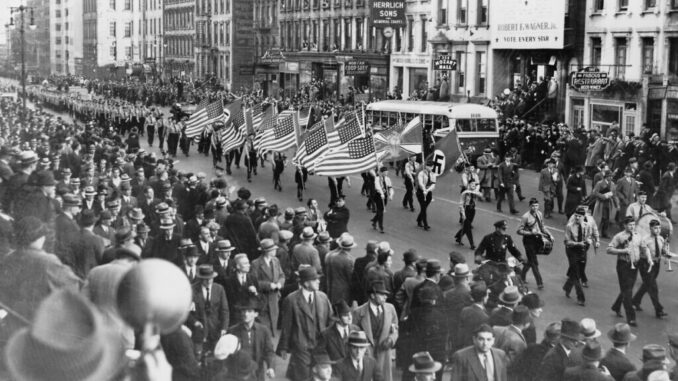
Carrying swastika flags, the German-American Bund parades down East 86th Street in New York City before a large rally at the Yorkville Casino. (New York World-Telegram and the Sun Newspaper Collection, Library of Congress, LC-USZ62-11748/courtesy Michael Benson)
New York judge Nathan D. Perlman was apparently a big believer in the adage: If you need a job done right, you’ve got to turn to the right people. So in 1938, he called up notorious Jewish mobster Meyer Lansky with a favor to ask of him.
Perlman called Lansky to a face-to-face meeting and asked him to direct Jewish gangsters to violently break up meetings of the German American Bund, a pro-Nazi organization for Americans of German origin.
Perlman asked if Lansky had some boys who would want to punch Nazis. Lansky said he most definitely did, and he suggested that they could do more than just beat the Bund members up.
“I want you to do anything but kill them,” Perlman warned the organized crime boss.
Prominent rabbi Stephen S. Wise, who was on hand to lend clerical gravitas, echoed the judge’s sentiment.
“I’m sorry, but we cannot condone killing,” he said.
This left Lansky to tell his associates they could “marinate” but not “ice” those who showed up at Bund meetings, rallies and marches, where speakers spewed Jew-hatred. Lansky gave his boys license to use more than their fists. Baseball bats, clubs and other street fighting paraphernalia were fair game. Guns were out of bounds, as were the ice picks, which were the preferred weapon of killer Abraham “Kid Twist” Reles.
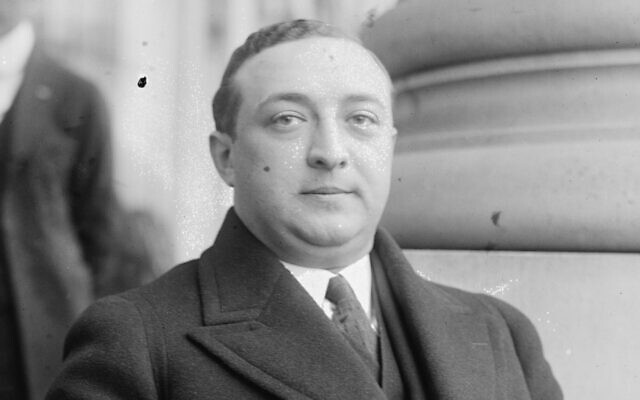
Judge Nathan Perlman would pick up a phone and call gangsters in New York, Newark, Minneapolis, Chicago, and LA to ask them to bust up Nazi meetings. (National Photo Company Collection, Library of Congress, Prints and Photographs Division, LC-DIG-npcc-03143)
A new book, “Gangsters vs. Nazis: How Jewish Mobsters Battled Nazis in Wartime America,” tells the fascinating story of how Perlman secretly directed an army led by Jewish gangsters across the United States in a successful yearlong campaign to squelch two key American Nazi organizations, the Bund and the Silver Legion (better known as the Silver Shirts).
Authored by prolific writer Michael Benson, the book provides the historical context for Perlman’s decision to give these organizations the extrajudicial punitive treatment.
Some 100 antisemitic groups operated in the United States in the Depression era. In an era before the passage of hate laws, these organizations were thoroughly protected by the freedom of speech granted by the First Amendment to the country’s constitution. As a result, these groups operated openly with impunity.
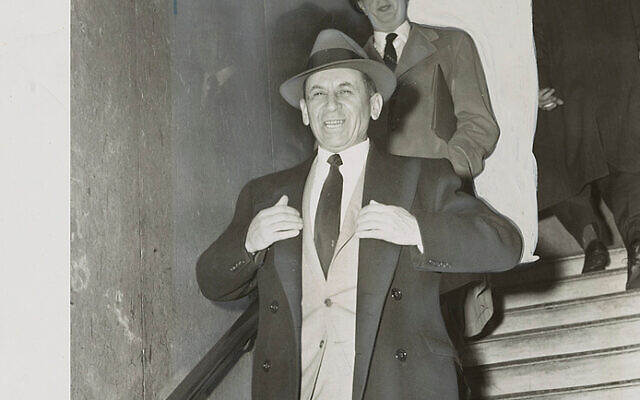
Judge Perlman’s first phone call was to Meyer Lansky, who had been instrumental in the formation of both New York City’s Five Family system and Murder Inc. (New York World-Telegram and the Sun Newspaper Collection, Library of Congress, LC-DIG-ds-00979)
The German American Bund promoted antisemitism and anti-Communism alongside its pro-Nazi and pro-isolationist agenda. The organization was closely aligned with antisemitic demagogue and radio personality Father Charles Coughlin‘s Christian Front.
“They said that the Jews were all Communists and they had all the money, which came as quite a shock to a lot of American Jews,” Benson said in an interview with The Times of Israel from his home in Brooklyn, New York.
While the Bund was really looking to Germany and propagandizing for the Nazi regime, it claimed to be a pro-American organization.
“The claim was always that they were American citizens looking out for America. When they had their rallies, there was always an American flag next to the swastika flag. A portrait of George Washington was next to the portrait of Hitler. The ‘big party’ at Madison Square Garden [in February 1939] was called the Pro-America rally. They were going to make America great,” Benson said.
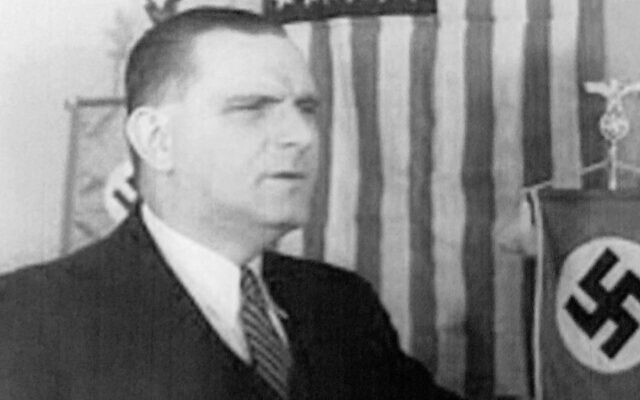
The leader of the German-American Bund (i.e., Bundesführer) was Fritz Julius Kuhn. He saw himself as America’s Hitler. (Alamy stock photo)
Although most of the approximately 25,000 dues-paying Bund members were American citizens of German origin, the group’s leaders, including top banana Fritz Kuhn were Germans who were never naturalized.
American Jews and community leaders were concerned and frightened. President Franklin D. Roosevelt’s government tried to act against pro-Nazi groups when and where possible. But there was nothing that could legally be done to shut them down.
Fed up with the situation, Perlman took matters into his own hands. As a former congressman and justice of the Court of Special Sessions of the City of New York, his role in intimidating law-abiding Americans would have to be kept on the down-low. So he requested the aid of men who wanted antisemites hurt, and had no compunction about acting outside the law.
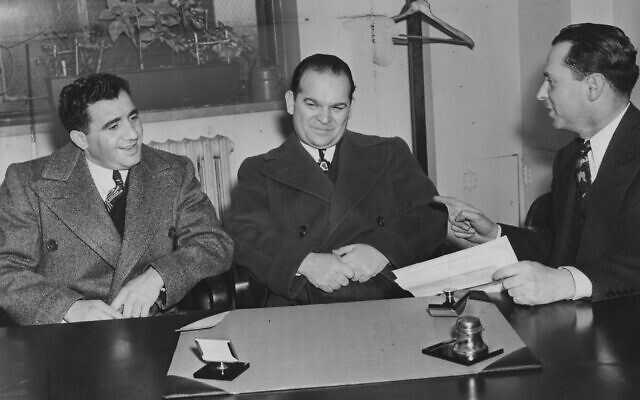
Abe ‘Kid Twist’ Reles (left) and Buggsy Goldstein (center) sharing a laugh. (Brooklyn Daily Eagle photograph, PORT-0744, Brooklyn Public Library, Center for Brooklyn History)
“The book takes place in that twilight zone between what is legal and what is just… The villains within the book are all within the law, and the heroes are all outside the law,” Benson said.
Despite the serious subject matter and nonstop violence, Benson said he deliberately wrote “Gangsters vs. Nazis” in a lighthearted style. He employs gangster lingo and explosive verbs throughout, evoking action movie or comic book imagery.
The book takes place in that twilight zone between what is legal and what is just
An attendee of a Bund meeting “slid down the wall like vanilla ice cream rolling down a cone” after being pummeled by a Jewish thug.
In one case, the Jewish guys ambushed Bund members as they left an event, leading to “intense action…looking like the flesh-eating frenzy of piranhas in otherwise still waters.”
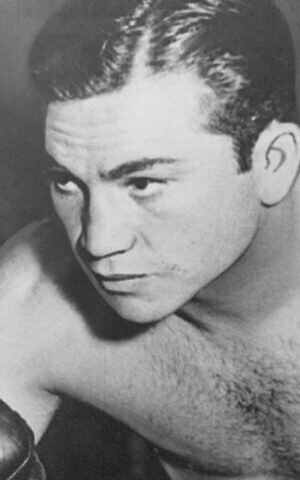
Barney Ross was the welterweight champion of the world when he was asked to help bust up a Bund meeting. (Collection of Michael Benson.)
Benson said he could only conceive of this story cinematically.
“It’s like an action film. Who doesn’t want to play a Jewish gangster who punches a befuddled Nazi?” Benson remarked.
Once things were underway in New York, Perlman reached out to Al Capone’s associate Jake “Greasy Thumb” Guzik in Chicago and asked him to do in the Windy City what Lansky was doing in the Big Apple. Key to the Chicago operation were Jewish boxers, including champion Barney Ross, as well as blond, blue-eyed Jewish journalist Herb Brin who went to Bund meetings undercover and collected valuable intelligence.
In New Jersey, Perlman relied on mob boss and bootlegger extraordinaire Abner “Longie” Zwillman. In turn, Zwillman looked to his pal ex-boxer and gym owner Nat Arno for help in recruiting Jewish tough guys. The ever-generous Zwillman covered all costs incurred these “Minutemen,” who saw themselves as the elite fighting force of the Revolutionary War.
In Middle America, the problem was not the Bund so much as William Dudley Pelley‘s Silver Legion. Many of the card-carrying 15,000 Silver Shirters and their supporters lived in Minnesota. Davie “The Jew” Berman, who ran the gambling scene in Minneapolis, was Perlman’s man. Berman even cooperated with rival Isadore “Kid Cann” Blumenfeld for this mission.
“Berman told Perlman it would be his honor to slap those Silver Shirt assholes around,” Benson wrote.
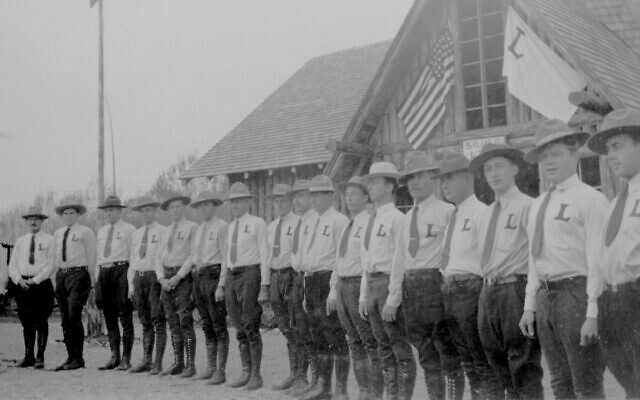
Pelley’s Silver Legion troops line up for inspection. (University Libraries, University of Washington, Special Collections, Collection: PH 1521.7, Negative no. UW 39260)
In Minneapolis, the gangsters worked closely with the community’s legitimate Jewish institutions. It is thanks to these organizations’ meticulous records that the story of how the Jewish toughs battled the Silver Shirts could be reconstructed, according to the author.
Nazi attempts to gain a direct foothold in La La Land began as early as 1933 and came directly from the Fuhrer himself. Hitler and chief Nazi propagandist Josef Goebbels sent scouts to Southern California to form active Nazi cells and plot horrific crimes against Jewish Hollywood moguls.
“Hitler thought that if he could take over the Hollywood propaganda machine, he’d maybe be able to conquer America without firing a shot, because he’d win the hearts and minds of Americans and people around the globe if Hollywood started making pro-Nazi movies,” Benson explained.
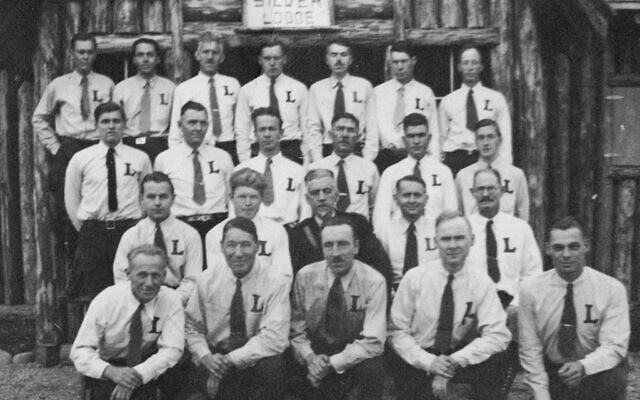
William Pelley (in the dark uniform) and Silver Legion members gather in front of the Silver Lodge in Redmond, Washington, in 1936. Note the toothbrush Hitler mustaches in the front and back rows. (University Libraries, University of Washington, Special Collections, Collection: PH 1521.9, Negative no. UW 39131)
Fortunately, things didn’t pan out as Hitler had wished thanks to counterespionage coordinated by Jewish attorney Leon L. Lewis. The spies, many of them women, reported back to Lawrence and to the FBI and US Naval Intelligence. The Nazi plan also fell apart thanks to backstabbing among the Nazi agents, because Hitler had not put any one of them definitively in charge.

‘Gangsters vs. Nazis: How Jewish Mobsters Battled Nazis in Wartime America’ by Michael Benson (Citadel)
But with the Bund and Silver Shirts active in LA by the late 1930s, Perlman called up Ben “Bugsy” Siegel and Mickey Cohen to take care of business there.
By 1939, the Jewish gangsters had pounded enough Nazis to ensure that a significant number of them quit attending meetings, or at least went underground. The gangsters’ actions had also emboldened ordinary Jews to protest and take action.
The gangsters were able to get away with cracking skulls and causing all kinds of bodily harm because the police (who were in the mob’s pockets) turned the other way. With fortunately no fatalities involved, the bloody fights never made the front page, and the perpetrators were never named.
Judge Perlman’s role in all of it was not revealed at the time. Perlman, who died in 1952, went on to serve as a senior official at the American Jewish Congress and to assist US Supreme Court Justice Robert H. Jackson, President Truman’s appointee to serve as chief US prosecutor of Nazi war criminals.
The story of Jewish gangsters beating up American Nazis was largely forgotten. When asked why this happened, Benson said he thought it was because of America’s entry into World War II after the Japanese attack on Pearl Harbor in December 1941. The Bund, Silver Front and similar organizations were outlawed and some of their leaders were interred as dangerous aliens.
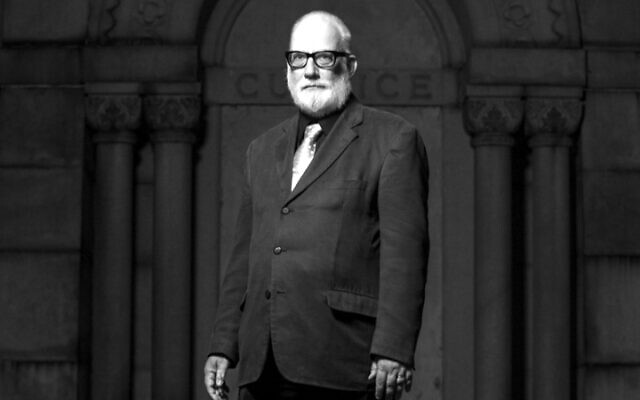
Michael Benson (Michael Hanlon)
In the book’s epilogue, Benson tells what happened to each of the characters. Some were drafted or volunteered to serve in the military. Some of the Jewish gangsters and fighters lived to an old age and passed away from natural causes. Others ended up in prison or dead due to mob violence. (Spoiler alert: Chicago’s Jacob “Sparky” Rubenstein moved to Dallas, ran nightclubs and changed his name to Jack Ruby. He became notorious for another crime completely.)
Benson’s take on this fascinating chapter in American history may be amusing, but for Judge Perlman there was nothing entertaining about Nazi activity in cities across the United States.
“It wasn’t the numbers [of American Nazis] that really upset Judge Perlman as much as it was the brazen way they behaved. It never occurred to them that they would encounter resistance. They assumed Jews were soft and would be afraid to fight back,” Benson said.



@Archie
Thanks for that. All new to me.
https://www.amazon.com/43-Group-Battling-Mosleys-Blackshirts/dp/0752499424
Written by a founding member, the remarkable history of an incredibly effective anti-fascist action group that shut down thousands of fascist meetings and rallies
Oswald Mosley decided he could carry on where Hitler and Mussolini had left off, and on street corners his fascist speakers would proclaim “not enough Jews were burned at Belsen.” Enter the 43 Group. In a ferocious, bloody, and brilliantly covert five-year campaign, they destroyed the Mosleyites. The membership of the Group was almost entirely made up of British servicemen, the original 43 members quickly swelling to more than 300 and including a Battle of Britain ace, a VC winner—and Vidal Sassoon. The Group’s philosophy of the “3 D’s”—Discuss, Decide and Do it—was quickly manifested on the streets of London, with literally thousands of fascist meetings and rallies sent packing. Quickly gaining a reputation, the 43 Group was organized in “wedges” of a dozen or so. These wedges would attend a British Union of Fascists rally and at a given signal would storm the speaker’s platform, attacking BUF stewards and speaker. The Group’s military background ensured tight discipline and brutally effective actions. This, combined with a number of spies within the fascist ranks, ensured the 43 Group almost always came out on top, closing down two-thirds of all fascist activity in the UK until its simultaneous demise with organized fascism in Britain in 1950.